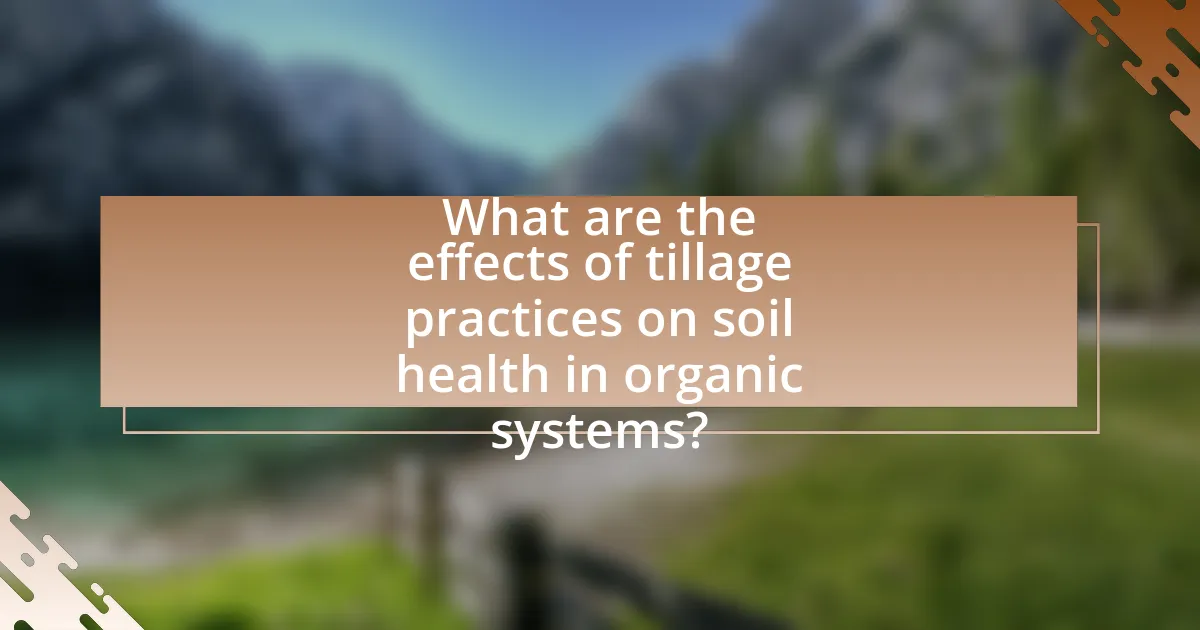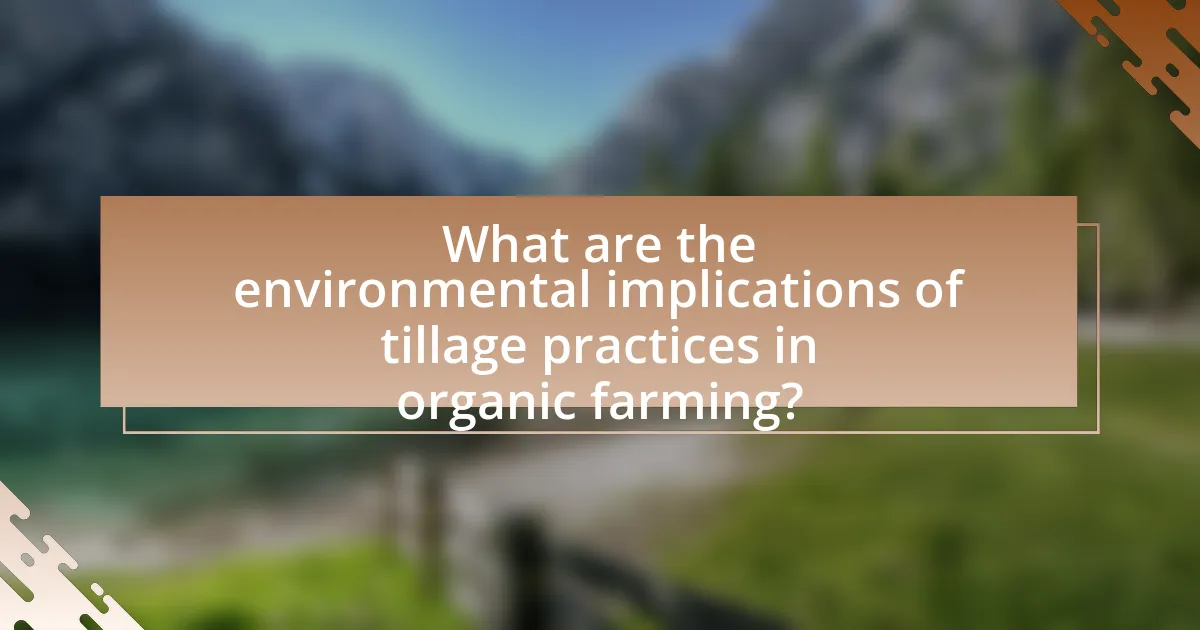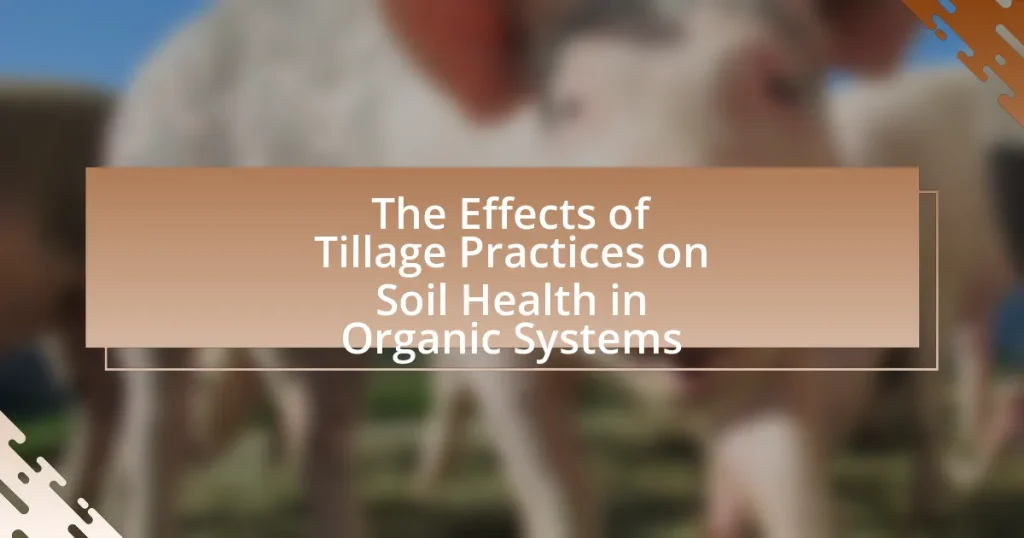The article examines the effects of tillage practices on soil health within organic farming systems, highlighting the significant impact of different tillage methods on soil structure, microbial activity, and nutrient availability. It discusses how reduced tillage enhances soil health by improving organic matter retention, microbial diversity, and nutrient cycling, while conventional tillage can lead to soil compaction, erosion, and decreased organic matter levels. Key findings from various studies illustrate the relationship between tillage practices and soil properties, including porosity, water retention, and carbon sequestration, emphasizing the importance of adopting sustainable tillage practices to promote soil health and agricultural productivity.

What are the effects of tillage practices on soil health in organic systems?
Tillage practices significantly impact soil health in organic systems by influencing soil structure, microbial activity, and nutrient availability. Reduced tillage enhances soil structure, promotes the formation of aggregates, and increases organic matter retention, which is crucial for maintaining soil fertility. Research indicates that reduced tillage can lead to higher levels of soil organic carbon, improving overall soil health. For instance, a study published in the journal “Agriculture, Ecosystems & Environment” by Pimentel et al. (2019) found that reduced tillage practices in organic farming systems resulted in improved soil microbial diversity and activity, which are essential for nutrient cycling and plant growth. Conversely, conventional tillage can lead to soil compaction, erosion, and loss of organic matter, negatively affecting soil health and productivity in organic systems.
How do different tillage practices influence soil structure?
Different tillage practices significantly influence soil structure by altering soil compaction, porosity, and aggregation. Conventional tillage, which involves intensive soil disturbance, often leads to increased compaction and reduced porosity, negatively impacting water infiltration and root growth. In contrast, conservation tillage practices, such as no-till or reduced-till, promote better soil aggregation and maintain higher organic matter levels, enhancing soil structure and overall health. Research indicates that no-till systems can improve soil structure by increasing earthworm activity and microbial diversity, which contribute to the formation of stable aggregates. Studies have shown that soils under no-till management exhibit 20-30% greater porosity compared to conventionally tilled soils, facilitating better water retention and aeration.
What specific changes occur in soil porosity with various tillage methods?
Different tillage methods significantly alter soil porosity, impacting soil health and structure. Conventional tillage typically reduces soil porosity due to soil compaction and disruption of soil aggregates, leading to a denser soil structure. In contrast, conservation tillage methods, such as no-till or reduced-till, maintain higher soil porosity by preserving soil structure and organic matter, which enhances pore space and aeration. Research indicates that no-till systems can increase soil porosity by 10-20% compared to conventional tillage, promoting better water infiltration and root growth. These changes in soil porosity directly affect soil health, nutrient availability, and overall ecosystem function in organic systems.
How does tillage affect soil compaction and its consequences?
Tillage significantly increases soil compaction, which negatively impacts soil health and crop productivity. When soil is tilled, the mechanical action compresses soil particles, reducing pore space and leading to denser soil. This compaction restricts root growth, limits water infiltration, and decreases aeration, ultimately hindering plant development. Research indicates that compacted soils can reduce crop yields by up to 30% due to impaired root systems and reduced nutrient availability. Therefore, the consequences of tillage-induced soil compaction are detrimental to both soil structure and agricultural output.
What role does tillage play in soil microbial activity?
Tillage significantly influences soil microbial activity by altering soil structure, aeration, and nutrient availability. When soil is tilled, it disrupts the habitat of microorganisms, which can lead to a temporary increase in microbial activity due to enhanced aeration and nutrient exposure. However, excessive tillage can also result in a decline in microbial diversity and biomass over time, as it can destroy fungal networks and reduce organic matter content. Research indicates that reduced tillage practices can promote higher microbial diversity and activity, contributing to improved soil health and resilience in organic systems. For instance, a study published in “Soil Biology and Biochemistry” by Six et al. (2004) found that reduced tillage enhances soil organic carbon levels, which supports a more diverse microbial community.
How does tillage frequency impact microbial diversity in organic soils?
Tillage frequency significantly impacts microbial diversity in organic soils by altering soil structure, nutrient availability, and habitat stability. Increased tillage frequency tends to reduce microbial diversity due to the disruption of soil aggregates and the loss of organic matter, which are critical for sustaining diverse microbial communities. Research indicates that reduced tillage practices can enhance microbial diversity by maintaining soil structure and promoting the accumulation of organic carbon, which serves as a food source for various microorganisms. For instance, a study published in “Soil Biology and Biochemistry” by Six et al. (2004) found that reduced tillage led to higher microbial biomass and diversity compared to conventional tillage methods.
What are the effects of tillage on soil organic matter levels?
Tillage significantly reduces soil organic matter levels. This reduction occurs because tillage disrupts soil structure, leading to increased oxidation and decomposition of organic matter. Research indicates that conventional tillage can decrease soil organic carbon by 30-50% over time compared to no-till systems, as highlighted in studies such as “Soil Organic Matter Dynamics in Tillage Systems” by Six et al. (2004). The mechanical disturbance from tillage exposes organic matter to air, accelerating its breakdown and diminishing its accumulation in the soil.
How do tillage practices affect nutrient availability in organic systems?
Tillage practices significantly influence nutrient availability in organic systems by altering soil structure, microbial activity, and organic matter decomposition. Conventional tillage often leads to soil compaction and erosion, which can reduce the soil’s ability to retain nutrients. In contrast, reduced tillage or no-till practices enhance soil structure and promote the proliferation of beneficial microorganisms, which are crucial for nutrient cycling. Research indicates that no-till systems can increase soil organic carbon levels by 20-30%, thereby improving nutrient availability. Additionally, studies have shown that reduced tillage can enhance the availability of nitrogen and phosphorus, essential nutrients for plant growth, by maintaining a more stable soil environment conducive to microbial activity.
What is the relationship between tillage and nitrogen cycling in organic soils?
Tillage significantly influences nitrogen cycling in organic soils by altering soil structure, microbial activity, and organic matter decomposition. When tillage is applied, it can enhance aeration and mixing, which may initially increase nitrogen mineralization rates. However, excessive tillage can lead to soil compaction and erosion, negatively impacting the long-term availability of nitrogen. Research indicates that reduced tillage practices can improve nitrogen retention and enhance soil organic matter, thereby promoting a more stable nitrogen cycle. For instance, a study published in the journal “Agriculture, Ecosystems & Environment” by Powlson et al. (2011) found that conservation tillage practices improved nitrogen use efficiency and reduced nitrogen leaching compared to conventional tillage methods.
How does tillage influence phosphorus and potassium availability?
Tillage influences phosphorus and potassium availability by altering soil structure, microbial activity, and nutrient distribution. Conventional tillage often leads to increased soil erosion and compaction, which can reduce the availability of these nutrients. For instance, studies have shown that reduced tillage practices enhance soil organic matter, improving nutrient retention and availability. Research indicates that no-till systems can increase phosphorus levels by 20-30% compared to conventional tillage, as they promote better root development and microbial activity that aids in nutrient cycling. Additionally, potassium availability can be enhanced in reduced tillage systems due to less disturbance of soil aggregates, which helps maintain moisture and nutrient levels.

What are the environmental implications of tillage practices in organic farming?
Tillage practices in organic farming significantly impact soil health and the surrounding environment. Conventional tillage can lead to soil erosion, loss of organic matter, and disruption of soil structure, which negatively affects soil biodiversity and water retention. Research indicates that reduced tillage or no-till practices can enhance soil carbon sequestration, improve soil fertility, and promote healthier ecosystems. For instance, a study published in the journal “Agriculture, Ecosystems & Environment” found that reduced tillage practices increased soil organic carbon levels by up to 30% compared to conventional tillage methods. This demonstrates that adopting sustainable tillage practices in organic farming can mitigate environmental degradation and enhance soil health.
How does tillage impact soil erosion rates?
Tillage significantly increases soil erosion rates by disrupting soil structure and reducing vegetation cover. When soil is tilled, the protective layer of organic matter and plant roots is disturbed, making the soil more susceptible to erosion by wind and water. Research indicates that conventional tillage can lead to erosion rates that are 10 to 100 times higher than those observed in no-till systems, as reported by the USDA Natural Resources Conservation Service. This disruption not only accelerates the loss of topsoil but also diminishes soil fertility and health over time.
What factors contribute to increased erosion in tilled soils?
Increased erosion in tilled soils is primarily caused by the disruption of soil structure and the loss of protective vegetation cover. Tillage practices break up soil aggregates, making it more susceptible to water and wind erosion. Additionally, the removal of crop residues and cover crops during tillage exposes the soil surface, reducing its ability to absorb rainfall and increasing runoff. Research indicates that conventional tillage can lead to a 50% increase in soil erosion rates compared to no-till systems, highlighting the significant impact of tillage on soil vulnerability.
How can reduced tillage practices mitigate erosion risks?
Reduced tillage practices mitigate erosion risks by maintaining soil structure and increasing organic matter retention. These practices minimize soil disturbance, which helps preserve the natural aggregation of soil particles, reducing the likelihood of erosion caused by water and wind. Research indicates that reduced tillage can lead to a 50% decrease in soil erosion rates compared to conventional tillage methods, as demonstrated in studies conducted by the USDA Natural Resources Conservation Service. By enhancing soil health through improved moisture retention and increased biodiversity, reduced tillage further contributes to the resilience of soil against erosive forces.
What are the effects of tillage on carbon sequestration?
Tillage negatively affects carbon sequestration by disrupting soil structure and increasing carbon dioxide emissions. Conventional tillage practices, such as plowing, expose soil organic matter to air, leading to accelerated decomposition and loss of stored carbon. Research indicates that reduced tillage or no-till practices can enhance carbon storage in soils by maintaining soil structure and promoting the accumulation of organic matter. For instance, a study published in “Soil and Tillage Research” found that no-till systems can increase soil organic carbon levels by up to 25% compared to conventional tillage methods over a period of several years.
How does tillage influence soil carbon storage in organic systems?
Tillage significantly reduces soil carbon storage in organic systems. This reduction occurs because tillage disrupts soil structure, leading to increased aeration and microbial activity, which accelerates the decomposition of organic matter. Research indicates that conventional tillage can decrease soil organic carbon levels by up to 30% compared to no-till practices, as shown in studies conducted by the USDA Agricultural Research Service. Additionally, tillage can lead to soil erosion, further depleting carbon stocks. Therefore, minimizing tillage is crucial for enhancing soil carbon storage in organic farming systems.
What practices can enhance carbon sequestration in tilled soils?
Practices that can enhance carbon sequestration in tilled soils include cover cropping, reduced tillage, and organic amendments. Cover cropping introduces biomass that contributes organic matter to the soil, which can increase carbon storage. Reduced tillage minimizes soil disturbance, preserving soil structure and microbial communities that aid in carbon retention. Organic amendments, such as compost or manure, enhance soil fertility and promote the formation of stable organic matter, further increasing carbon sequestration potential. Research indicates that these practices can significantly improve soil organic carbon levels, with studies showing increases of up to 30% in carbon stocks when implemented effectively.
How does tillage affect water retention and drainage in organic soils?
Tillage negatively affects water retention and drainage in organic soils by disrupting soil structure and reducing organic matter content. When tillage is performed, it breaks apart soil aggregates, leading to increased compaction and decreased pore space, which impairs the soil’s ability to hold water. Research indicates that conventional tillage can reduce soil organic carbon levels by up to 50% over time, which is crucial for maintaining soil moisture. Additionally, studies show that no-till practices can enhance water infiltration rates and retention, demonstrating that reduced tillage improves the hydrological properties of organic soils.
What are the implications of tillage on soil moisture levels?
Tillage significantly impacts soil moisture levels by altering the soil structure and its ability to retain water. Conventional tillage practices often lead to increased evaporation and reduced moisture retention due to soil compaction and disruption of soil aggregates. Research indicates that no-till systems can enhance soil moisture conservation by maintaining surface residues, which reduce evaporation rates and improve infiltration. For instance, a study published in the “Soil Science Society of America Journal” found that no-till practices can increase soil moisture levels by up to 20% compared to conventional tillage methods. This demonstrates that tillage practices directly influence soil moisture dynamics, affecting overall soil health and crop productivity.
How can tillage practices be adjusted to improve water management?
Adjusting tillage practices to improve water management involves implementing conservation tillage methods, such as reduced tillage or no-till systems. These practices enhance soil structure, increase organic matter retention, and improve water infiltration rates, which collectively lead to better moisture retention in the soil. Research indicates that conservation tillage can reduce soil erosion by up to 90% compared to conventional tillage, thereby preserving soil moisture and enhancing water availability for crops. Additionally, these practices can promote the development of soil aggregates, which further aids in water retention and reduces runoff, ultimately leading to more efficient water management in agricultural systems.

What best practices can be adopted for tillage in organic systems?
Best practices for tillage in organic systems include minimal tillage, crop rotation, cover cropping, and the use of organic amendments. Minimal tillage reduces soil disturbance, preserving soil structure and microbial communities, which are crucial for soil health. Crop rotation enhances biodiversity and disrupts pest and disease cycles, leading to healthier crops. Cover cropping prevents soil erosion, improves soil fertility, and enhances moisture retention. The application of organic amendments, such as compost or manure, enriches soil nutrient content and promotes beneficial microbial activity. These practices collectively contribute to improved soil health and sustainability in organic farming systems.
What are the recommended tillage practices for enhancing soil health?
Recommended tillage practices for enhancing soil health include reduced tillage, no-till farming, and cover cropping. Reduced tillage minimizes soil disturbance, which helps maintain soil structure and promotes microbial activity. No-till farming preserves soil moisture and organic matter, leading to improved nutrient cycling. Cover cropping, which involves planting specific crops during off-seasons, enhances soil fertility and prevents erosion. Research indicates that these practices can significantly improve soil organic carbon levels and overall soil health, as evidenced by studies showing that no-till systems can increase soil organic matter by up to 30% over time.
How can cover cropping complement tillage practices in organic farming?
Cover cropping can complement tillage practices in organic farming by enhancing soil structure, improving nutrient cycling, and reducing erosion. When cover crops are integrated with tillage, they contribute organic matter to the soil, which increases soil aggregation and water retention. Research indicates that cover crops can also suppress weeds and reduce the need for herbicides, thereby promoting a healthier ecosystem. For instance, a study published in the journal “Agronomy for Sustainable Development” found that cover crops significantly improved soil organic carbon levels and microbial activity, which are crucial for soil health in organic systems.
What role does crop rotation play in improving soil health alongside tillage?
Crop rotation significantly enhances soil health by promoting biodiversity and improving nutrient cycling, particularly when combined with tillage practices. This agricultural method reduces soil erosion, enhances soil structure, and increases organic matter content, which are critical for maintaining soil fertility. Research indicates that rotating crops can lead to a decrease in soil-borne diseases and pests, as different crops can disrupt the life cycles of harmful organisms. Additionally, studies have shown that crop rotation can improve soil microbial diversity, which is essential for nutrient availability and overall soil health. For instance, a study published in the journal “Agriculture, Ecosystems & Environment” found that diverse crop rotations increased soil organic carbon levels and microbial biomass, thereby enhancing soil quality.
How can farmers assess the impact of their tillage practices?
Farmers can assess the impact of their tillage practices by monitoring soil health indicators such as soil structure, organic matter content, and microbial activity. These indicators provide measurable data that reflect the effects of different tillage methods on soil quality. For instance, studies have shown that reduced tillage can enhance soil organic matter levels by up to 30% compared to conventional tillage, leading to improved soil structure and increased microbial diversity. Additionally, farmers can utilize soil testing and field observations to evaluate changes in crop yield and resilience, which are directly influenced by tillage practices.
What indicators should be monitored to evaluate soil health in organic systems?
To evaluate soil health in organic systems, key indicators include soil organic matter, microbial biomass, nutrient availability, soil pH, and soil structure. Soil organic matter is crucial as it enhances nutrient retention and improves soil structure, which is supported by studies showing that higher organic matter levels correlate with increased soil fertility. Microbial biomass indicates biological activity and health, with research indicating that diverse microbial communities contribute to nutrient cycling and disease suppression. Nutrient availability, particularly nitrogen, phosphorus, and potassium, is essential for plant growth, and soil tests can quantify these levels. Soil pH affects nutrient solubility and microbial activity, with optimal ranges typically between 6.0 and 7.5 for most crops. Lastly, soil structure, assessed through aggregate stability and porosity, influences water infiltration and root penetration, which are vital for crop health. Monitoring these indicators provides a comprehensive assessment of soil health in organic farming systems.
How can soil testing inform better tillage decisions?
Soil testing can inform better tillage decisions by providing precise data on soil nutrient levels, pH, and organic matter content, which are critical for optimizing tillage practices. This data allows farmers to tailor their tillage methods to the specific needs of their soil, enhancing soil health and crop productivity. For instance, a study published in the “Journal of Soil and Water Conservation” found that soil testing can lead to a 20% increase in crop yields when tillage practices are adjusted based on soil nutrient availability. By understanding the soil’s condition, farmers can minimize erosion, improve water retention, and enhance microbial activity, all of which contribute to sustainable agricultural practices.
What practical tips can farmers implement to optimize tillage practices?
Farmers can optimize tillage practices by implementing reduced tillage methods, which minimize soil disturbance and enhance soil health. Reduced tillage, such as no-till or strip-till, helps maintain soil structure, increases organic matter retention, and promotes beneficial microbial activity. Research indicates that these practices can lead to improved water retention and reduced erosion, ultimately enhancing crop yields. For instance, a study published in the journal “Agronomy” found that no-till systems can increase soil organic carbon levels by up to 30% over time, demonstrating the long-term benefits of optimized tillage practices.










